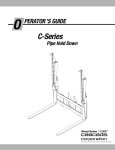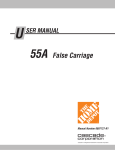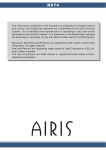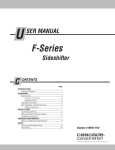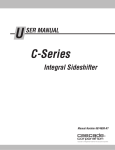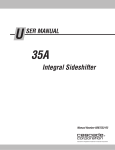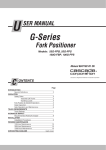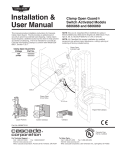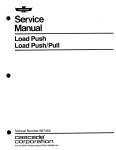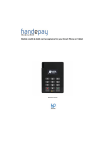Download 213580R4_E,F & G Single-Double Operator Guide
Transcript
O perator’s Guide E,F & G-Series Single-Double Pallet Handler Manual Number 213580-R4 cascade corporation Cascade is a Registered Trademark of Cascade Corporation C oNTents Introduction 1 Safety Rules 2 Daily Inspection 4 Attachment Operation 5 Picking Up Loads 5 WARNING: Rated capacity of the truck/ attachment combination is a responsibility of the original truck manufacturer and may be less than shown on the attachment nameplate. Consult the truck nameplate. Safe Operation and Maintenance OSHA Regulations I WARNING: Do not operate this attachment unless you are a trained and authorized lift truck driver. 6 ntroduction Single-Double Pallet Handler – The Cascade SingleDouble Pallet Handler is designed to handle both single pallets or two pallets side by side. The attachment has an integral sideshifting function. Single-Doubles are used for transport, stacking, van trailer or boxcar loading and breakout. About this Guide – The information in this guide is intended to simplify operator understanding about effective and safe attachment use and operation. Read this guide thoroughly before operating the attachment. Be sure you know and understand all operating procedures and safety precautions. If you have any questions, or don’t understand a procedure, ask your supervisor. Backrests Hydraulic Cylinders Frame Emphasize Safety! Most accidents are caused by operator carelessness or misjudgement. You must watch for hazardous situations and correct them. Arm Bars SD0549.eps Inner Forks Outer Forks 213580-R4 s afEty rulES industrial lift trucks No reaching through mast No riders No standing underload SD0082.eps tilt when traveling loaded With load Raise 10cm No load P P ramPS traveling empty Motor off, park, lower load P No turning on ramp No parking on ramp Watch clearances SD0083.eps traffic STOP observe Wet floors 23580-R4 Workers stops Bumps dips slow for two-way traffic sound horn, slow at intersection sound horn, slow at corner 2 S afety rules Top of load should not extend above backrest. Limit sideshift operation with raised load. Load weight must not exceed attachment capacity (see attachment nameplate). SD0421.eps Limit truck movement with raised load. Center load prior to lifting and traveling. Do not clamp on loads or pallets KEEP FORKS INSIDE FRAME WHEN: •Traveling empty • Going into trailers empty • Backing out of trailers empty Stay clear of pinch points. SD0551.eps SD0552.eps 213580-R4 S afety rules Handling Loads Forks spread for single pallet load Forks centered under multiple pallet loads SD0422.eps No stacked or half-loads D AILY INSPECTION Check items each day. Report problems to your supervisor. See the Service Manual for maintenance and repair procedures. Upper hook engagement Safety Decals SD0550.eps Fasteners 213580-R4 Hydraulic leaks Lower hook engagement a ttacHmEnt oPEration SidESHiftinG a Sideshift Left B Sideshift Right c Spread Forks d Retract Forks A B C D CL0526.eps C auXiliary ValVE functionS Hoist down Tilt forward A C B D GA0005.eps p Hoist up Tilt back icKinG uP loadS SPrEadinG loadS • Position forks under load • raise forks to engage load • Spread load 2 • lower forks to release load • move forks inward 3 • raise forks to engage load • Spread load narroWinG loadS (SnaPPinG) 5 • Position forks under load • raise forks to engage load • move forks inward 2 • lower forks to release load • move forks outward 3 SD0003.eps • raise forks to engage load • move forks inward 23580-R4 S afe operation and maintenance OSHA Regulations – Industrial Trucks and Attachments (Specific Regulations from OSHA 1910.178) WARNING: The safe operation and maintenance of industrial trucks is regulated by Occupational Safety and Health (OSHA) regulations 1910.178 and Ameri- can National Standards Institute (ANSI) Safety Standard for Powered Industrial Trucks, ANSI B56.1. When operating and maintaining industrial trucks equipped with attachments you should pay particular attention to the following sections of these regulations. You should be familiar with all sections of these regulations. Ask your employer for the complete regulations. (6) A safe distance shall be maintained from the edge of ramps or platforms while on any elevated dock or platform or freight car. Trucks shall not be used for opening or closing freight doors. (10) A load backrest extension shall be used whenever necessary to minimize the possibility of the load or part of it from falling rearward. (n) Traveling (4) The driver shall be required to slow down and sound the horn at cross isles and other locations where vision is obstructed. If the load being carried obstructs forward view, the driver shall be required to travel with the load trailing. (7i) When ascending or descending grades in excess of 10 percent, loaded trucks shall be driven with the load upgrade. (7iii) On all grades the load and load engaging means shall be tilted back if applicable, and raised only as far as necessary to clear the road surface. (a) General Requirement (4) Modifications and additions which affect capacity and safe operation shall not be performed by the customer or user without manufacturers prior written approval. Capacity, operation and maintenance instruction plates, tags or decals shall be changed accordingly. (5) If the truck is equipped with front-end attachments other than factory installed attachments, the user shall request that the truck be marked to identify the attachments and show the appropriate weight of the truck and attachment combination at maximum elevation with load laterally centered. (6) The user shall see that all nameplates and markings are in place and maintained in a legible condition. (e) Safety Guards (2) If the type of load presents a hazard, the user shall equip fork trucks with a vertical load backrest extension in accordance with (a)(2) following. (a)(2) All new powered industrial trucks acquired and used by an employer after February 15, 1972 shall meet the design and construction requirements for powered industrial trucks established in the “American National Standard for Powered Industrial Trucks, Part II, ANSI B56.1”, except for vehicles intended primarily for earth moving or over-the-road hauling. (o) Loading (1) Only stable or safely arranged loads shall be handled. Caution shall be exercised when handling off-center loads which cannot be centered. (2) Only loads within the rated capacity of the truck shall be handled. (3) The long or high (including multiple-tiered) loads which may affect capacity shall be adjusted. (4) Trucks equipped with attachments shall be operated as partially loaded trucks when not handling a load. (5) A load engaging means shall be placed under the load as far as possible; the mast shall be carefully tilted backward to stabilize the load. (6) Extreme care shall be used when tilting the load forward or backward, particularly when high tiering. Tilting forward with load engaging means elevated shall be prohibited except to pick up a load. An elevated load shall not be tilted forward except when the load is in a deposit position over a rack or stack. When stacking or tiering, only enough backward tilt to stabilize the load shall be used. (l) Operator Training Only trained and authorized operators shall be permitted to operate a powered industrial truck. Methods shall be devised to train operators in the safe operation of powered industrial trucks. (m) Truck Operations (1) Trucks shall not be driven up to anyone standing in front of a bench or other fixed object. (2) No person shall be allowed to stand or pass under the elevated portion of any truck, whether loaded or empty. (3) Unauthorized personnel shall not be permitted to ride on powered industrial trucks. A safe place to ride shall be provided where riding of trucks is authorized. (4) The employer shall prohibit arms or legs from being placed between the uprights of the mast or outside the running lines of the truck. (5i) When a powered industrial truck is left unattended, load engaging means shall be fully lowered, controls shall be neutralized, power shall be shut off and brakes set. Wheels shall be blocked if the truck is parked on an incline. (5ii)A powered industrial truck is unattended when the operator is 25 feet or more away from the vehicle which remains in his view, or whenever the operator leaves the vehicle and it is not in his view. (5iii)When the operator of an industrial truck is dismounted and within 25 feet of the truck still in his view, the load engaging means shall be fully lowered, controls neutralized and the brakes set to prevent movement. 213580-R4 (p) Operation of the Truck (1) If at any time a powered industrial truck is found to be in need of repair, defective, or in any way unsafe, the truck shall be taken out of service until it has been restored to safe operating condition. (q) Maintenance of Industrial Trucks (1) Any power-operated industrial truck not in safe operating condition shall be removed from service. All repairs shall be made by authorized personnel. (5) All parts of any such industrial truck requiring replacement shall be replaced only by parts equivalent as to safety with those used in the original design. (6) Industrial trucks shall not be altered so that the relative positions of the various parts are different from what they were when originally received from the manufacturer, nor shall they be altered either by the addition of extra parts not provided by the manufacturer or by the elimination of any parts. Additional counter-weighting of fork trucks shall not be done unless approved by the truck manufacturer. (7) Industrial trucks shall be examined before being placed in service and shall not be placed in service if the examination shows any condition adversely affecting the safety of the vehicle. Such examinations shall be made at least daily. When industrial trucks are used on a round-the-clock basis, they shall be examined after each shift. Defects when found shall be immediately reported and corrected. Do you have questions you need answered right now? Call your nearest Cascade Service Department. Visit us online at www.cascorp.com AMERICAS Cascade Corporation U.S. Headquarters 2201 NE 201st Fairview, OR 97024-9718 Tel: 800-CASCADE (227-2233) Fax: 888-329-8207 Cascade do Brasil Rua João Guerra, 134 Macuco, Santos - SP Brasil 11015-130 Tel: 55-13-2105-8800 Fax: 55-13-2105-8899 Cascade Canada Inc. 5570 Timberlea Blvd. Mississauga, Ontario Canada L4W-4M6 Tel: 905-629-7777 Fax: 905-629-7785 EUROPE-AFRICA Cascade Italia S.R.L. European Headquarters Via Dell’Artigianato 1 37030 Vago di Lavagno (VR) Italy Tel: 39-045-8989111 Fax: 39-045-8989160 Cascade (Africa) Pty. Ltd. PO Box 625, Isando 1600 60A Steel Road Sparton, Kempton Park South Africa Tel: 27-11-975-9240 Fax: 27-11-394-1147 ASIA-PACIFIC Cascade Japan Ltd. 2-23, 2-Chome, Kukuchi Nishimachi Amagasaki, Hyogo Japan, 661-0978 Tel: 81-6-6420-9771 Fax: 81-6-6420-9777 Cascade Korea 121B 9L Namdong Ind. Complex, 691-8 Gojan-Dong Namdong-Ku Inchon, Korea Tel: +82-32-821-2051 Fax: +82-32-821-2055 Cascade-Xiamen No. 668 Yangguang Rd. Xinyang Industrial Zone Haicang, Xiamen City Fujian Province P.R. China 361026 Tel: 86-592-651-2500 Fax: 86-592-651-2571 Cascade Australia Pty. Ltd. 1445 Ipswich Road Rocklea, QLD 4107 Australia Tel: 1-800-227-223 Fax: +61 7 3373-7333 Cascade New Zealand 15 Ra Ora Drive East Tamaki, Auckland New Zealand Tel: +64-9-273-9136 Fax: +64-9-273-9137 Sunstream Industries Pte. Ltd. 18 Tuas South Street 5 Singapore 637796 Tel: +65-6795-7555 Fax: +65-6863-1368 Cascade India Material Handling Private Limited No 34, Global Trade Centre 1/1 Rambaugh Colony Lal Bahadur Shastri Road, Navi Peth, Pune 411 030 (Maharashtra) India Phone: +91 020 2432 5490 Fax: +91 020 2433 0881 c Cascade Corporation 2006 11-2006 Part Number 213580-R4








